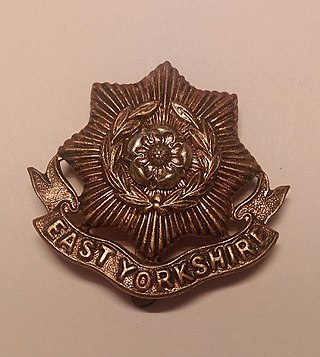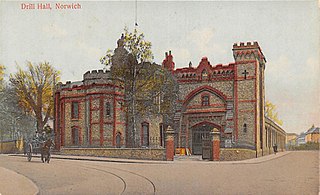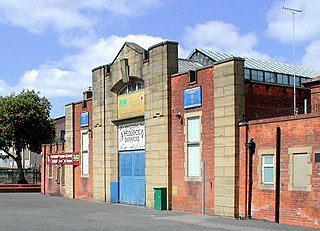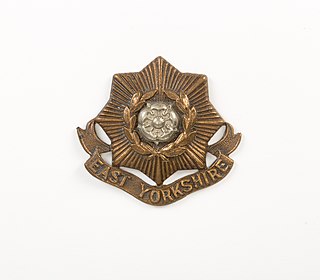
The Prince of Wales's Own Regiment of Yorkshire was an infantry regiment of the British Army, part of the King's Division. It was created in 1958 by the amalgamation of the West Yorkshire Regiment and the East Yorkshire Regiment. After 48 years service, the regiment was amalgamated again, this time with two other Yorkshire regiments. It became the 1st Battalion of the Yorkshire Regiment, with the Green Howards forming the 2nd Battalion and the Duke of Wellington's Regiment forming the 3rd Battalion on 6 June 2006. Following further merges, in 2012, the battalion was redesignated as the new 2nd Battalion (2Yorks).

4th Light Brigade Combat Team, previously known as 4th Infantry Brigade and Headquarters North East, and before that as 4th Mechanized Brigade and before that 4th Armoured Brigade is a brigade formation of the British Army, currently based in Catterick, North Yorkshire as part of 1st Division. The brigade, now known as the 'Black Rats', was formed in 1939 and fought in the Second World War in the Western Desert Campaign in North Africa. The Black Rats were subsequently involved in the invasion of Sicily and fighting in Italy before taking part in the Battle of Normandy and the advance through Belgium, Holland and into Germany.

The 11th Security Force Assistance Brigade is a brigade of the British Army which is intended to train and assist foreign forces. In 2021, under the Future Army changes, the brigade was redesignated, formerly being the 11th Infantry Brigade & HQ South East. Prior to the Army 2020 changes in 2013, the brigade was temporarily activated for deployment to Afghanistan. Originally formed in the Second Boer War, the brigade was engaged during both World Wars.

The East Yorkshire Regiment was a line infantry regiment of the British Army, first raised in 1685 as Sir William Clifton's Regiment of Foot and later renamed the 15th Regiment of Foot. It saw service for three centuries, before eventually being amalgamated with the West Yorkshire Regiment in 1958, to form the Prince of Wales's Own Regiment of Yorkshire. Subsequently, the regiment amalgamated with the Green Howards and the Duke of Wellington's Regiment to form the Yorkshire Regiment on 6 June 2006.

William Henry Forester Denison, 1st Earl of Londesborough, known as The Lord Londesborough from 1860 to 1887, was a British peer and Liberal politician. He was also one of the main founders of Scarborough FC.
150 Regiment RLC is a reserve regiment of the Royal Logistic Corps of the British Army.
This is the Operation Herrick ground order of battle, which lists any British ground forces that have taken part in the duration of Operation Herrick between 2002 and 2014.
In September 1939, the British Army was in process of expanding their anti-aircraft and mobile assets. Among these new changes was the formation of Anti-Aircraft Command which was formed on 1 April 1939, and the 1st Armoured Division formed in 1937. The list below will include the British Army units, colonial units, and those units which were in the process of formation.

Kendrew Barracks is a British Army barracks located 1.1 miles (1.8 km) north east of Cottesmore, Rutland, England. The barracks opened in 2012, on the site of the former RAF Cottesmore.
Army 2020 was the name given to the restructuring of the British Army in the early and mid-2010s, in light of the Strategic Defence and Security Review 2010. The plan, as its name suggested, was intended to be completed by 2020, though most of its reorganisations were completed by the middle of the decade. It was succeeded by Army 2020 Refine, a series of new changes and refinements of Army 2020's restructuring, conducted in light of the Strategic Defence and Security Review 2015.

Imphal Barracks is a military installation located in Fulford, York, England. The site will close in 2030.

Maindy Barracks is a military installation in the Cathays district of Cardiff in Wales.

The page contains the current structure of the British Army. The British Army is currently being reorganised to the Future Soldier structure.

The Colliergate drill hall is a former military installation at the corner of Colliergate and St Andrewgate in York.

The Chapel Field Road drill hall was a military installation in Norwich, Norfolk.

The Tower Street drill hall is a military installation in York. It lies on Tower Street, in the city centre.

Wenlock Barracks is a military installation on Anlaby Road in Kingston upon Hull, England.

The 5th (Cyclist) Battalion, East Yorkshire Regiment was a mobile coast defence unit of Britain's Territorial Force. It was formed in 1908 from a nucleus provided by a Volunteer battalion first raised in 1859. It carried out its defence duties along the East Coast throughout World War I and after the war it was incorporated into a unit of the new Royal Corps of Signals.
Future Soldier is a reform of the British Army resulting from the Integrated Review of Security, Defence, Development and Foreign Policy published in March 2021. The aim of the reform is to create a more lethal, agile and expeditionary force, able to fight and win wars and to operate in the grey-zone between peace and war. Future Soldier was published on 25 November 2021 and deals with the organizational changes of the British Army, with changes to personnel and equipment were set out in the Defence in a Competitive Age paper published on 22 March 2021.















